Navigating Towards Sustainability: Green Practices in Digital Wayfinding

In an era where environmental consciousness is paramount, industries are increasingly embracing sustainable practices to reduce their ecological footprint. One such sector making strides in sustainability is digital wayfinding, where innovative technologies are transforming navigation while minimising environmental impact.
Traditional navigation methods often rely on paper maps, signage, and other materials that contribute to waste and pollution. “Consider this: according to The World Counts, 420 million tons of paper corresponds to two pieces of paper for everyone on Earth every single hour. Despite technological advancements, we're not yet a paperless society. In fact, demand for paper is expected to double between 2005 and 2030, exacerbating environmental concerns.”
“The environmental effects of paper production are staggering. Deforestation, energy consumption, water usage, air pollution, and waste problems are just some of the consequences. Shockingly, paper accounts for around 26% of total waste at landfills, highlighting the urgent need for sustainable alternatives.”
Enter digital wayfinding solutions. By leveraging technology, these platforms offer a paperless alternative to traditional navigation methods, significantly reducing paper consumption and its associated environmental impacts. Here's how digital wayfinding is paving the way towards a more sustainable future:
Paperless Navigation:
Digital wayfinding eliminates the need for printed maps and signage, reducing paper waste and deforestation. Users can access interactive maps and directions directly from their smartphones or digital devices, leading to a significant reduction in paper consumption.
Route Optimisation:
Advanced algorithms analyse real-time data to optimise navigation routes, reducing unnecessary travel and fuel consumption. Whether navigating indoor environments or urban landscapes, users can rely on digital wayfinding solutions to find the most efficient pathways, thus minimising their carbon footprint.
Data-Driven Insights:
Digital wayfinding solutions collect valuable data on user behaviour and traffic patterns. This data enables organisations to make informed decisions to improve efficiency and sustainability, such as optimising building layouts or implementing eco-friendly transportation options.
While Living Map is committed to integrating sustainability into our digital wayfinding products, we are proud of the progress we've made thus far. Through our focus on paperless navigation, route optimisation, and data-driven insights, we empower organisations to navigate towards a greener future while enhancing the way people explore and interact with their surroundings. Join us in our mission to pave the way towards sustainability in digital navigation.
- References:
The World Counts, Environmental Impact of Paper. Retrieved from https://www.theworldcounts.com/challenges/consumption/other-products/environmental-impact-of-paper
Request a demo
Experience the power of our mapping, wayfinding, and navigation technology for yourself. See how our software can enhance the customer experience in your facility.





